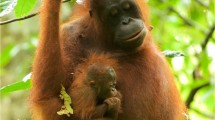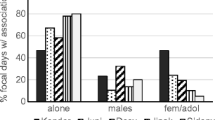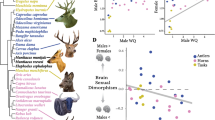Abstract
In contrast to other papionin monkeys, hamadryas baboons are characterized by female-biased dispersal. Given that hamadryas females do not disperse voluntarily, one mechanism for female transfer between bands is thought to be abductions during aggressive intergroup conflict. To date, however, no successful abductions have been witnessed. We describe three abduction events at the Filoha field site in Ethiopia, two interband and one intraband, in which the abductors successfully separated a female from her leader male for several minutes or hours. In each case, the original leader male located the abductor and retrieved the female, even if it involved entering the social sphere of another band. These observations suggest that a hamadryas leader male will risk injury and loss of additional females in his attempt to retrieve a female from an abductor unless the abductor has openly challenged the leader for possession of his female and physically defeated him.


Similar content being viewed by others
References
Abegglen JJ (1984) On socialization in hamadryas baboons: a field study. Bucknell University Press, Lewisburg
Bachmann C, Kummer H (1980) Male assessment of female choice in hamadryas baboons. Behav Ecol Sociobiol 6:315–321
Hammond RL, Lawson Handley LJ, Winney BJ, Bruford MW, Perrin N (2006) Genetic evidence for female-biased dispersal and gene flow in a polygynous primate. Proc R Soc B 273:479–484
Hapke A, Zinner D, Zischler H et al (2001) Mitochondrial DNA variation in Eritrean hamadryas baboons (Papio hamadryas hamadryas): life history influences population genetic structure. Behav Ecol Sociobiol 50:483–492
Kummer H (1968) Social organization of hamadryas baboons. The University of Chicago Press, Chicago
Kummer H, Götz W, Angst W (1974) Triadic differentiation: an inhibitory process protecting pair bonds in baboons. Behaviour 49:62–87
Moore J (1984) Female transfer in primates. Int J Primatol 5:537–589
Pines M, Saunders J, Swedell L (2011) Alternative routes to the leader male role in a multi-level society: follower versus solitary male strategies and outcomes in hamadryas baboons. Am J Primatol (in press)
Schreier A, Swedell L (2009) The fourth level of social structure in a multi-level society: ecological and social functions of clans in hamadryas baboons. Am J Primatol 71:948–955
Sigg H, Stolba A, Abegglen J-J, Dasser V (1982) Life history of hamadryas baboons: physical development, infant mortality, reproductive parameters and family relationships. Primates 23:473–487
Swedell L (2000) Two takeovers in wild hamadryas baboons. Folia Primatol 71:169–172
Swedell L (2006) Strategies of sex and survival in hamadryas baboons: through a female lens. Pearson Prentice Hall, Upper Saddle River
Swedell L (2011) African papionins: diversity of social organization and ecological flexibility. In: Campbell CJ, Fuentes A, MacKinnon KC, Bearder SK, Stumpf RM (eds) Primates in perspective, 2nd edn. Oxford University Press, New York, pp 241–277
Swedell L, Schreier A (2009) Male aggression towards females in hamadryas baboons: conditioning, coercion, and control. In: Muller MN, Wrangham RW (eds) Sexual coercion in primates and humans: an evolutionary perspective on male aggression against females. Harvard University Press, Cambridge, pp 244–268
Swedell L, Saunders J, Schreier A, Davis B, Tesfaye T, Pines M (2011) Female ‘dispersal’ in hamadryas baboons: Transfer among social units in a multi-level society. Am J Phys Anthropol (in press)
Acknowledgments
We are grateful to the National Geographic Society, the Leakey Foundation, the Wenner-Gren Foundation, and the PSC-CUNY Research Award Program for funding this research. We are also grateful to the New York Consortium in Evolutionary Primatology (NYCEP), City University of New York, the Ethiopian Wildlife Conservation Authority, and the Awash National Park Baboon Research Project for their cooperation and affiliation. We thank Teklu Tesfaye, Brittany Davis, Amy Schreier, and Julian Saunders for their contributions to the ongoing data collection for the Filoha Hamadryas Project and Helga Peters for permission to use her photo. Finally, we thank Teklu Tesfaye, Demekech W/aregay, and the staff of Awash National Park for their logistical support. This research was approved by and complied with regulations of the Ethiopian Wildlife Conservation Authority and the Queens College Institutional Animal Care and Use Committee.
Author information
Authors and Affiliations
Corresponding author
About this article
Cite this article
Pines, M., Swedell, L. Not without a fair fight: failed abductions of females in wild hamadryas baboons. Primates 52, 249–252 (2011). https://doi.org/10.1007/s10329-011-0242-x
Received:
Accepted:
Published:
Issue Date:
DOI: https://doi.org/10.1007/s10329-011-0242-x




